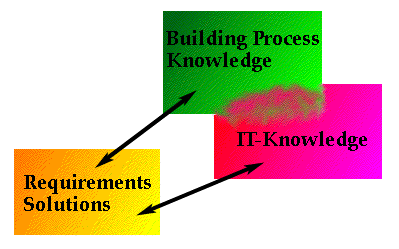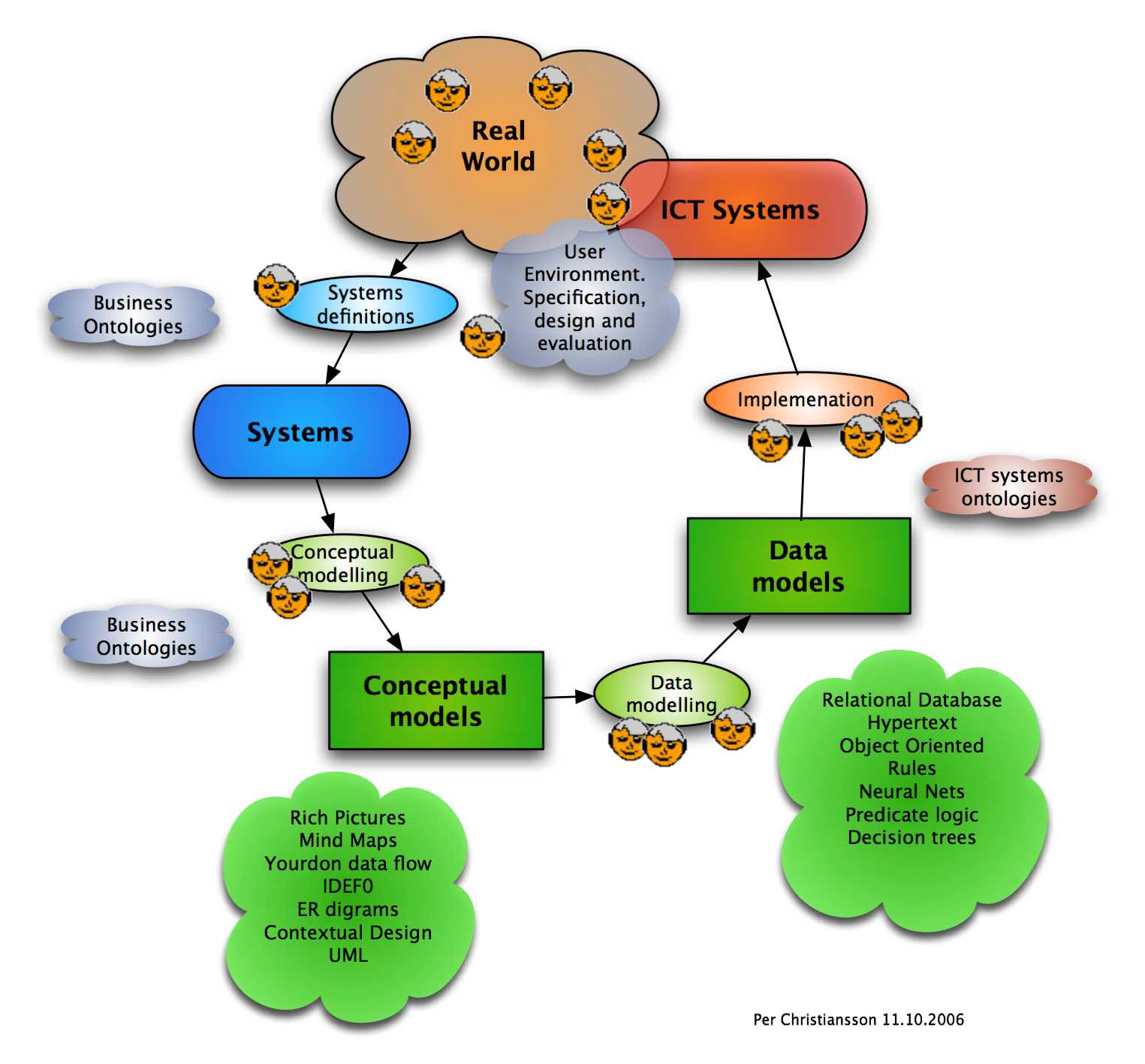|
|
The motivation for the course
From the course home page
"Since the introduction of the world wide web (WWW) and standardisation of Internet services and communication protocols we can see a huge shift in the way we communicate, collaborate and handle digital knowledge. The semester 7 course focuses on models and representations of building products and processes. (In the semester 8 course we take an end user perspective on how ICT tools can support collaboration, communication and access to Internet based computer resources.)
The anticipated ICT tools are only partly developed and must be designed tested and implemented in close collaboration with the building process end users. This requires that civil engineers get a deeper understanding of some knowledge domains that up till now only has been partly covered in the civil engineering curricula.
The ICT will strongly influence how we take advantage of and interact with the computer resources
- information storage and interaction media will be more separated (paper is both)
- it will be easier to adapt information containers to user needs and usage context (meta data, models interoperability, model access, etc.)
- buildings and building processes will be more effectively and efficiently represented in digital models with different knowledge representations.
- the web will form the infrastructure for information container access, and application communication
- human collaboration, team work and communication modes will be developed and partly changed
- collaboration work spaces will get a added virtual dimension being less dependent of the physical room.
The mutual influence between practice and ICT progress is necessary to maintain. Civil engineers must posses both general and some specialised ICT related knowledge to be able to specify and participate in the development of new ICT tools and to be pro-active in the process of changing work routines and company and project organisation.
This course aims at providing general knowledge on how
present and future digital product and process models can be designed and implemented as well as deeper knowledge in certain key areas such as conceptual modelling methods, different knowledge representation properties, web-database integration, the semantic web, and model integration.
See also Building Informatics Overview
and Steinman, 2004, The Job Profile of Construction Informatics"

Figure 1. Builders must know some basic IT to be able to formulate requirements on and participate in the design and implementation of tomorrows building process IT-tools.
The IT community cannot (should not) by themselves build tomorrows AEC tools
Course Content
We focus in this course on modelling (in a formal way represent) different activities, things and information/knowledge in our real world. In this way we can end up with models that can be stored not only as descriptions on paper but implemented in computer systems to support us in the real world. We can for example build virtual building models to support us in design, construction and use of buildings.

- Real world (activities, things, processes, context, persons)
- The real world can be described as (interrelated)systems to accomplish different functions (e.g. a heating system to provide personal and artifact living and working quality, load carrying building system).
- The systems are modelled in context.
- Conceptual models more or less formal (rich pictures, E-R diagrams, IDEF0,...)
- Data models in formal representations (OO systems, relational db, hypertext,...) are designed
- Implementation of data models in physical information handling systems
- Evaluation of systems performance and usability testing
Figure 2. FROM REAL WORLD TO ICT SUPPORTED SYSTEMS
The course is build up of a series of lectures and linked exercises covering the following areas
- 'World - Model - System' with motivations for the course and overview of course content. We define IT and some central concepts such as system, models, and BIM. We get a background on ICT development and how it influences the building process.
- 'Conceptual Modelling'. We now look at the first step of the development of support systems, see also figure 2, and tools to support conceptual modelling i.e. high level modelling of different functional systems (activities, thongs etc. in the real world).
- 'ICT development in construction practice'. This (guest) lecture gives us examples from real life on implementation of building process ICT support systems. We look for example on how Virtual models linked with Physical Building Components will beneficially change the building process. We have now hopefully gained a deeper understanding of the need for and possibilities to develop new building process ICT support systems.
- 'Knowledge Representation'. Before we try to find suitable more formalised models to represent our real world functional systems, we look at different types of data models (and as it sometimes called knowledge representations). For example Objects Oriented representations, relational databases (relational algebra), logic representations, hypertext and combinations of these. See also Figure 3.
- 'WEB and Databases'. In these 3 lectures we learn specifically more about relational database data models and also how they can be integrated with web based hypertext representations (and thus accessible from the Internet).
- 'The Semantic Web'. In these 2 lectures we learn specifically more about hypertext representations i.e. linked containers of information (containing documents, images, etc.). We understand how information storage and access media can be divided using XML and how concepts and their relations can be defined on higher abstraction levels to support deeper descriptions (and thus human and machine understanding) of information that can be found in WWW based information containers (Semantic Web).
- 'The Digital City and Intelligent Buildings'. Finally we give examples on how the buildings themselves can be equipped with more sophisticated ICT systems to enhance the performance of the buildings (and the build environment). The buildings can be more responsive to different activates in context such as work, living, and operation & maintenance.
| Functional System |
Knowledge Representation |
| Building room design |
Cad system containing an Object Oriented representations of rooms including room relations and attributes. Can also be represented in relational databases.
|
| Product catalogue for a window manufacturer |
A database with window type descriptions.
The database can be made accessible on the Internet
through web-pages using HyperText representations (html, xml documents). The Database and Hypertext data models are linked through e.g. ASP/HTML documents where the logics can be represented with if-then rules in ASP SCIPTS.
|
| Early prototype of a company knowledge management (KM) system |
Hypertext documents (html) emulating the ICT KM system. After/during evaluations,
changes can easily be made. An early conceptual model of the KM-system can be used as input.
|
| Indoor climate system control |
Artifical neural network (ANN) that learns from daily end user behaviour.
|
| Design decision support system |
Object oriented representation combined with a rule-representation working on the object attributes.
|
Figure 3. Example on datamodels/knowedge representations that can support different real world functional systems
Student background knowledge
The students should preferably have some experience in software programming languages (procedural or object oriented) and basic html as well as Internet functionality and structure.
Literature
According to '5.4 Literature' (8 references) plus slides from the lectures (those with bold text in the left slide-overview list).
Examination
Oral individual test based on 15 minutes discussion outgoing from the course exercises. Assessed with the grade "passed" or "failed" with internal censor participation. There is no time for preparation. Below some examples on questions that can be put are listed 'Questions Examples from lecture notes'. See also the cited course Goal description below
"The student shall gain knowledge on fundamental concepts, technologies and methods for analyses and development of models describing a buildings functional systems, building processes and models for knowledge management on the World Wide Web.
The student shall at the final examination be able to
- Describe how processes and products in the real world can be described as models that can be implemented in ICT support system
- Have knowledge about when different conceptual modelling methods can be used
- Know principles and methods for establishing web-database connections
- Have knowledge about properties of different knowledge representations and their usefulness for modelling different functional real world systems. Focus is on relational databases, hypertext and rule-based representations.
- (Knowledge about Service Oriented Architectures to support system interoperability and access to user services.)
- Know the principles for building Semantic Web based representations including knowledge about the Extensible Stylesheet Language Family, XSL(T)
- Knowledge about building services provided by Intelligent Buildings"
Questions Examples from lecture notes
World Models and Systems
- Give some examples on digital models we can build for the building process.
- Why do we build digital building process/product models?
- What is a digital Virtual Building model?
- Give some examples on services we can implement in an office intranet.
- How can digital models help us communicate with product/component manufacturer?
- What is ICT?
- Give some examples on how ICT is pushing us into the knowledge society.
Conceptual Modelling
- Why do we need top make conceptual models of our applications that we want to store in the computer systems as digital models?
- Draw a functional model graph of the following application - selection and ordering of windows for an office building with special regard to the communication with the window producer.
- Give examples on conceptual modelling methods and the corresponding application systems they are well suited to model.
- Describe over time different activities in ICT system design.
- ((Sketch work models (according to the Contextual Design method) for the internal structure and information flow on use of system for drawing and document handling on an office intranet.))
ICT tools in practice
- Give examples on some benefits we will obtain by linking virtual models with real objects in construction
- How can virtual building models and physical buildings be linked?
Knowledge Representations
- How can we represent knowledge in computers?
- Give some examples of computer stored knowledge representations/data models
and describe their properties and possible application domains.
- What do you mean characterizes a knowledge management system?
WEB and DATABASES
- What characterizes a relational database? (Explain the first three levels of relational database normalisation).
- What is Structured Query Language, SQL. Explain the 'select', 'from', and 'where' clauses.
- Explain how a database can be accessed from the Internet via a web browser
(using ODBC Open Database Connectivity).
The Semantic Web
- What is XML, XSL and XML schema?
- How can XML formatted data support application interoperability on WWW?
- What is the Semantic Web?
The Digital City and Intelligent Buildings
- Sketch an example on an intelligent building installation and services based on LON, Local Operating Network,
- Mention four important benefits using Intelligent Building
Installations.
- Which competences (and why) would you involve in design, build-up and operation/maintenance of
the intelligent building installations, IBI?
- Which types of services can be introduced in the digital city information
networks?
- Discuss capacity and other properties of different networking
technologies that can be used in the digital city.
- Which competences (and why) would you involve in design, build-up, and operation/maintenance of
the digital city?
|
|






